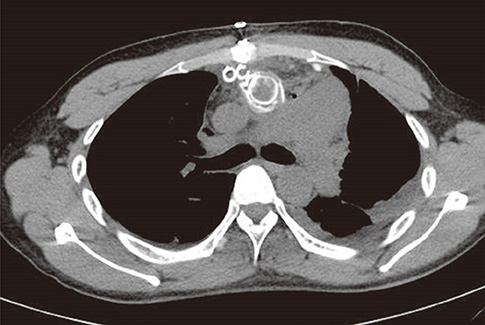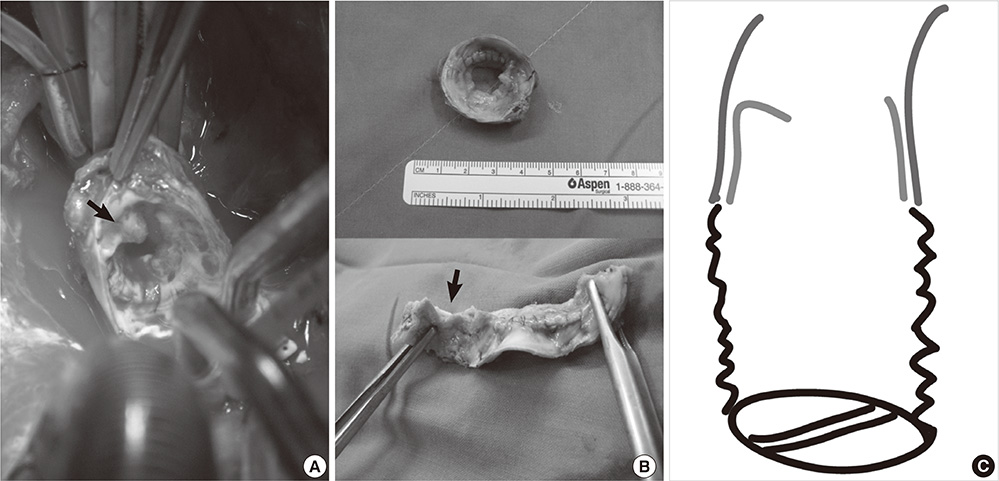J Korean Med Sci.
2013 Dec;28(12):1827-1829. 10.3346/jkms.2013.28.12.1827.
Hemolytic Anemia Case Caused by an Inverted Inner Felt after Bentall Operation
- Affiliations
-
- 1Department of Anesthesia and Pain Medicine, Chung-Ang University Hospital, Seoul, Korea.
- 2Department of Thoracic and Cardiovascular Surgery, Chung-Ang University Hospital, Seoul, Korea. jhong@cau.ac.kr
- 3Department of Cardiology, Chung-Ang University Hospital, Seoul, Korea.
- KMID: 1779427
- DOI: http://doi.org/10.3346/jkms.2013.28.12.1827
Abstract
- A 26-yr-old male patient reported worsened dyspnea, dizziness one year after an emergency Bentall operation for type A aortic dissection. There was evidence of hemolytic anemia and aortogram revealed a significant stenosis at the distal anastomosis site. During the reoperation, we found the inner felt at the distal anastomosis was inverted causing a significant stenosis. The reoperation successfully resolved this problem. Here, we report a rare case of hemolytic anemia caused by an inverted inner felt after Bentall operation.
Keyword
MeSH Terms
-
Acute Disease
Adult
Anastomosis, Surgical
Anemia, Hemolytic/*diagnosis/*etiology/surgery
Aneurysm, Dissecting/complications/*surgery
Aortic Aneurysm/complications/*surgery
*Blood Vessel Prosthesis
Blood Vessel Prosthesis Implantation/*adverse effects/instrumentation
Dizziness/etiology
Dyspnea/etiology
Echocardiography
Humans
Male
*Postoperative Complications/surgery
Reoperation
Time Factors
Tomography, X-Ray Computed
Treatment Outcome
Figure
Reference
-
1. Bedetti CD, Siewers RD, Dunsford HA. Teflon felt embolism of coronary arteries after cardiac surgery: a case report. Am Heart J. 1978; 96:802–805.2. Sogawa M, Moro H, Namura O, Ishiyama T, Hayashi J. Thrombus on the intraluminal felt strip: a possible cause of postoperative stroke. Jpn J Thorac Cardiovasc Surg. 2001; 49:333–335.3. Hata M, Yoshitake I, Wakui S, Unosawa S, Hata H, Shiono M. Postoperative early hemolytic anemia due to inverted teflon felt strip after emergency repair for type A dissection. Thorac Cardiovasc Surg. 2011; 60:482–484.4. Izumi S, Tano K, Horike K, Kaihotsu N. Repeat surgery for hemolysis 6 years after replacement of the ascending aorta for acute aortic dissection. Jpn J Thorac Cardiovasc Surg. 2003; 51:459–461.5. Nakamura Y, Ogino H, Matsuda H, Minatoya K, Sasaki H, Kitamura S. Hemolytic anemia after operation for aortic dissection using teflon felt strips. Ann Thorac Surg. 2008; 85:1784–1787.6. Shingu Y, Aoki H, Ebuoka N, Eya K, Takigami K, Oba J, Chiba K, Fukuhara T. A surgical case for hemolytic anemia after ascending and total arch replacement. Ann Thorac Cardiovasc Surg. 2005; 11:416–418.7. Luzzatto L. Hemolytic anemias and anemia due to acute blood loss. In : Longo D, Fauci A, Kasper D, Hauser S, Jameson J, Loscalzo J, editors. Harrison's principle of internal medicine. 18th ed. New York: McGraw-Hill;2012. p. 872–886.8. Cesare ED, Giordano AV, Cerone G, De Remigis F, Deusanio G, Masciocchi C. Comparative evaluation of TEE, conventional MRI and contrast-enhanced 3D breath-hold MRA in the post-operative follow-up of dissecting aneurysms. Int J Card Imaging. 2000; 16:135–147.9. García A, Ferreirós J, Santamaría M, Bustos A, Abades JL, Santamaría N. MR angiographic evaluation of complications in surgically treated type A aortic dissection. Radiographics. 2006; 26:981–992.
- Full Text Links
- Actions
-
Cited
- CITED
-
- Close
- Share
- Similar articles
-
- A Case of Autoimmune Hemolytic Anemia Caused by Warm Antibody
- A case of Wilson disease associated with hemolytic anemia and cholelithiasis
- A new paradigm in the diagnosis of hereditary hemolytic anemia
- A Case of Autoimmune Hemolytic Anemia after Fludarabine Treatment in Waldenstrom Macroglobulinemia
- A Case of Microangiopathic Hemolytic Anemia after Myxoma Excision and Mitral Valve Repair Presenting as Hemolytic Uremic Syndrome




